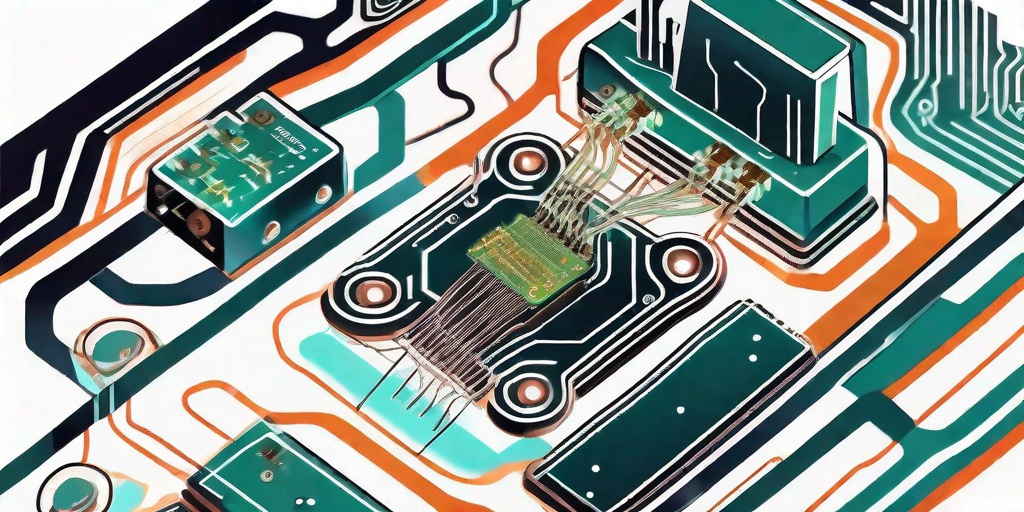Understanding Robotics Through an Innovation Speaker's Insight

Understanding Robotics Through an Innovation Speaker's Insight
Robots have long captured our imagination, from the science fiction tales of Isaac Asimov to the mechanized wonders of our favorite childhood toys. But in recent years, the world of robotics has transcended fictional realms and become an integral part of our reality. As technology advances at an unprecedented pace, we find ourselves at the cusp of a new era—one where our interactions with robots are no longer confined to the silver screen, but rather woven into the fabric of our daily lives.
Understanding Robotics Basics
Before delving into the intricacies of this brave new world, it is crucial to establish a solid foundation of knowledge. Robotics, at its core, is the branch of technology that deals with the design, construction, and application of robots. These machines, often programmed with artificial intelligence, are capable of carrying out tasks autonomously or with minimal human intervention. From self-driving cars to surgical assistants, the capabilities of robots are vast and ever-expanding.
Central to understanding robotics is grasping the interdisciplinary nature of the field. Robotics combines insights from various scientific and engineering disciplines, including computer science, electrical engineering, mechanical engineering, and even psychology. By integrating these diverse fields of study, robotics pioneers are able to push the boundaries of what machines can achieve.
One fascinating aspect of robotics is the concept of artificial intelligence (AI). AI allows robots to learn from their environment and adapt their behavior accordingly. This ability to learn and improve over time is what sets robots apart from traditional machines. Through complex algorithms and advanced programming, robots can analyze data, make decisions, and perform tasks with a level of sophistication that was once thought to be exclusive to humans.
Furthermore, the field of robotics is not limited to just physical robots. Virtual robots, also known as software robots or bots, play a significant role in various industries. These virtual counterparts can automate repetitive tasks, such as data entry or customer service, freeing up human workers to focus on more complex and creative endeavors. With the rise of artificial intelligence and machine learning, virtual robots are becoming increasingly intelligent and capable.
When it comes to the design and construction of robots, engineers must consider a wide range of factors. One crucial aspect is the mechanical design, which involves creating a physical structure that can perform the desired tasks efficiently and reliably. This includes selecting the appropriate materials, designing joints and actuators, and ensuring the overall stability and durability of the robot.
Another important consideration is the electrical design, which involves the integration of various electronic components and systems. This includes sensors to gather data about the robot's environment, motors to control its movements, and power sources to provide energy. The electrical design must be carefully planned and implemented to ensure the robot functions optimally and safely.
Additionally, the software aspect of robotics is equally vital. Programming a robot involves writing code that enables it to perform specific tasks and respond to different stimuli. This can range from simple commands to complex algorithms that involve decision-making and problem-solving. The software must be meticulously developed and tested to ensure the robot behaves as intended and can adapt to changing circumstances.
Lastly, the field of robotics also considers ethical and societal implications. As robots become more integrated into our daily lives, questions arise about their impact on employment, privacy, and human interaction. Ethical considerations, such as ensuring the safety and well-being of humans and preventing discrimination, are crucial in the development and deployment of robots.
The Role of an Innovation Speaker in Advancing Robotics Knowledge
With robotics evolving at such a rapid pace, it is crucial for individuals and organizations to stay informed about the latest developments. This is where an innovation speaker with expertise in robotics comes into play. Their role is not only to educate and inspire, but also to bridge the gap between cutting-edge research and real-world applications.
An innovation speaker brings a unique perspective to the table, drawing from their own experiences in the field. Through captivating talks and insightful discussions, they provide a platform for professionals and enthusiasts alike to gain a deeper understanding of robotics. From highlighting the latest breakthroughs to addressing ethical concerns, an innovation speaker equips their audience with the knowledge necessary to navigate the intricacies of this technologically-driven world.
One of the key aspects of an innovation speaker's role is to showcase the incredible potential of robotics. They delve into the various industries where robotics is making a significant impact, such as healthcare, manufacturing, and transportation. By sharing real-life examples and success stories, they paint a vivid picture of how robotics is revolutionizing these sectors.
Moreover, an innovation speaker goes beyond the technical aspects of robotics and explores the broader implications for society. They discuss the ethical considerations surrounding the use of robotics, including issues of privacy, job displacement, and the potential for bias in artificial intelligence algorithms. By engaging in thought-provoking conversations, they encourage their audience to critically analyze the impact of robotics on our lives and to actively participate in shaping its future.
Another important role of an innovation speaker is to inspire individuals to pursue careers in robotics. By sharing their own journey and passion for the field, they ignite a spark of curiosity and motivation in their listeners. They highlight the diverse range of opportunities available in robotics, from research and development to entrepreneurship. Through their stories, they encourage aspiring roboticists to embrace challenges, think creatively, and contribute to the advancement of this exciting field.
Furthermore, an innovation speaker fosters collaboration and networking within the robotics community. They create a space for professionals, researchers, and enthusiasts to connect, exchange ideas, and form partnerships. By facilitating these interactions, they contribute to the growth of a vibrant and supportive ecosystem that fuels innovation and drives progress in robotics.
In conclusion, an innovation speaker plays a crucial role in advancing robotics knowledge. Through their expertise, captivating talks, and thought-provoking discussions, they educate, inspire, and bridge the gap between cutting-edge research and real-world applications. They showcase the potential of robotics, address ethical concerns, inspire future roboticists, and foster collaboration within the robotics community. As robotics continues to evolve, the role of innovation speakers becomes increasingly important in shaping the future of this transformative field.
The Impact of Robotics on Various Industries
While it is easy to envision robots as mere playthings or futuristic gadgets, their influence extends far beyond our imagination. Robotics has already begun revolutionizing numerous industries, with no sign of slowing down.
One notable area where robotics has made a significant impact is manufacturing. Automation has allowed companies to streamline production processes, resulting in increased efficiency and reduced costs. Industrial robots, equipped with advanced sensors and software, can perform repetitive tasks with incredible precision, freeing up human workers to focus on more complex and creative endeavors.
But robotics is not limited to the factory floor. In healthcare, robots are being used to support medical professionals in various ways, from assisting in surgical procedures to providing companionship for the elderly. These robots are designed to enhance patient care and improve outcomes. For example, robotic surgical systems enable surgeons to perform minimally invasive procedures with greater precision, resulting in faster recovery times and reduced risk of complications. Additionally, robots are being used in rehabilitation settings to assist patients with physical therapy exercises, providing personalized guidance and support.
The agricultural industry is also benefiting from robotic advancements. Autonomous machines are being utilized for various tasks, such as planting, harvesting, and monitoring crops. These robots are equipped with advanced sensors and imaging technology, allowing them to analyze soil conditions, detect pests and diseases, and optimize irrigation and fertilization processes. By automating these tasks, farmers can increase crop yields, reduce resource waste, and improve overall farm management.
Furthermore, the transportation and logistics sector is experiencing a significant transformation due to robotics. Autonomous vehicles, such as self-driving cars and delivery drones, are being developed and tested to revolutionize the way goods and people are transported. These vehicles have the potential to improve road safety, reduce traffic congestion, and enhance the efficiency of supply chains. In addition, robotic systems are being used in warehouses and distribution centers to automate order fulfillment processes, enabling faster and more accurate deliveries.
Another industry where robotics is making waves is construction. Robotic systems are being used for tasks such as bricklaying, concrete pouring, and demolition. These robots can work tirelessly and with great precision, reducing construction time and improving the quality of the final product. Additionally, drones equipped with cameras and sensors are being used for surveying and inspecting construction sites, providing valuable data to project managers and engineers.
It is important to note that the impact of robotics goes beyond individual industries. The development and implementation of robotics technology have significant implications for the global economy, job market, and society as a whole. As robots continue to evolve and become more sophisticated, it is crucial for policymakers, educators, and businesses to adapt and embrace these advancements to ensure a smooth transition and maximize the benefits for everyone.
Practical Insights from an Innovation Speaker on Robotics
Delving deeper into the world of robotics, an innovation speaker offers practical insights that can be applied in real-life scenarios. By sharing their expertise and experiences, they assist individuals and organizations in harnessing the true potential of robotics.
One key aspect emphasized by an innovation speaker is the importance of human-robot collaboration. Rather than viewing robots as competitors, the speaker encourages us to embrace their capabilities and use them as complementary tools. The speaker highlights examples where robots enhance human productivity, such as in warehouses where autonomous robots work alongside human employees to fulfill orders efficiently.
Furthermore, the speaker sheds light on the ever-evolving ethical implications of robotics. Issues such as data privacy, job displacement, and the potential for weaponization require careful consideration as we navigate the uncharted waters of this technological revolution. By fostering discussions and posing thought-provoking questions, the innovation speaker ensures that these crucial conversations remain at the forefront of our collective consciousness.
Future Perspectives on Robotics Development
As we peer into the future, the possibilities of robotics seem boundless. Advancements in artificial intelligence, machine learning, and sensor technology are poised to push the boundaries of what robots can achieve. From robotics for space exploration to advancements in humanoid robots, the future holds tremendous promise.
However, it is important to approach these developments with vigilance. An innovation speaker reminds us that while the potential benefits of robotics are undeniable, it is imperative to navigate this terrain responsibly. Ethical frameworks, governance mechanisms, and ongoing research are vital to ensuring that robotics serves the greater good.
Conclusion
Understanding robotics through the lens of an innovation speaker allows us to grasp the complexities and potential of this rapidly evolving field. From mastering the basics to exploring its impact on various industries, an innovation speaker equips us with the knowledge necessary to navigate this exciting technological landscape. By embracing innovation and approaching robotics with a critical mindset, we can shape a future where robots are not just tools, but partners in our journey towards progress.
Frequently Asked Questions
1. What is robotics and how does it relate to artificial intelligence?
Robotics is the branch of technology that deals with the design, construction, and application of robots. These machines, often programmed with artificial intelligence, can carry out tasks autonomously or with minimal human intervention. Artificial intelligence allows robots to learn from their environment and adapt their behavior accordingly, enabling them to analyze data, make decisions, and perform tasks with a level of sophistication.
2. What are the key considerations in the design and construction of robots?
When designing and constructing robots, engineers must consider several factors. The mechanical design involves creating a physical structure that can perform tasks efficiently and reliably, selecting appropriate materials, designing joints and actuators, and ensuring overall stability and durability. The electrical design integrates various electronic components and systems, such as sensors, motors, and power sources, to ensure optimal and safe functioning. Additionally, the software aspect involves programming the robot to perform specific tasks and respond to different stimuli, ranging from simple commands to complex algorithms.
3. How is robotics impacting different industries?
Robotics is revolutionizing various industries. In manufacturing, automation with robots increases efficiency and reduces costs. In healthcare, robots support medical professionals in surgical procedures and rehabilitation, improving patient care and outcomes. The agricultural industry benefits from autonomous machines that optimize crop management. The transportation and logistics sector is transforming with self-driving cars and automated warehouses. Robotics is also making an impact in construction, improving productivity and quality. These advancements have implications for the global economy, job market, and society as a whole.
Contact a Innovation Speaker for your event
Having read about the intricate world of robotics and the transformative potential it holds for various industries, why not take the next step and bring this wealth of knowledge directly to your next event? Dr Mark van Rijmenam, a renowned innovation speaker, is poised to captivate your audience with his expert insights into robotics, artificial intelligence, and the future of technology. With his unique ability to translate complex concepts into engaging narratives, Dr van Rijmenam will not only educate your audience but also inspire them to embrace the opportunities that lie ahead in this technologically-driven era. Don't miss out on this opportunity to add an extra dimension of depth and relevance to your event. Simply complete the form below and we will be in touch within 24 hours to discuss how Dr van Rijmenam can best serve your needs.
Thanks for your inquiry
We have sent you a copy of your request and we will be in touch within 24 hours on business days.
If you do not receive an email from us by then, please check your spam mailbox and whitelist email addresses from @thedigitalspeaker.com.
In the meantime, feel free to learn more about The Digital Speaker here.
Or read The Digital Speaker's latest articles here.





